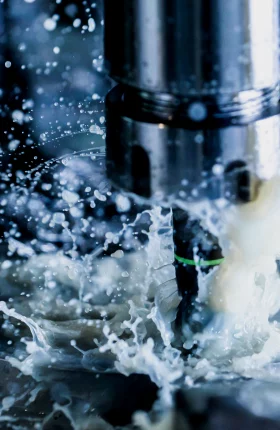For many industrial companies, pursuing the Industrial Internet of Things (IIoT) is like probing a new galaxy: exciting and seemingly limitless, yet unfamiliar and largely uncharted. Similarly, IIoT’s importance is potentially huge. BCG estimates that the value of the IoT market will hit €250 billion by 2020, and we expect IIoT to be one of the fastest-growing and largest segments, growing at a compound annual rate of 30% and accounting for roughly €80 billion. Among industrial companies, machinery and component vendors are striving to offer leading-edge IIoT solutions as they seek ways to differentiate themselves from competitors.
However, developing and deploying IIoT solutions has been more difficult than these vendors expected, mainly for two reasons. First, the machinery and components industry long lacked the standardized communications protocols, network capabilities, and cybersecurity solutions that vendors needed to quickly and cost-effectively implement IIoT technologies. Second, vendors were hindered by internal roadblocks; for example, employees lacked the skills necessary to innovate digitally. Additionally, customers’ adoption of IIoT solutions has been slower than expected because the anticipated return on investment has often been unclear or unmet.
To capitalize on the potential of IIoT, machinery and component vendors need more than the will to succeed; they need a guide. Just as The Hitchhikers Guide to the Galaxy helped Arthur Dent journey through space in the classic science-fiction book of the same name, this report aims to help vendors navigate this expansive new territory, make use of new technologies, and build partner ecosystems. To create this guide, we surveyed 100 machinery and component vendors around the globe to understand their current approaches to IIoT.
The Time Is Right for IIoT
According to our survey, more than 70% of machinery and component vendors said that they expect more than 5% of their company’s total revenues to come from sales of new IIoT solutions within the next five years. Moreover, these vendors anticipate that the rise of IIoT will affect the level of importance they assign to each product they offer. Although they currently view IIoT-enabled solutions as their least important offerings, these respondents agreed that such solutions will become their most important offerings within the next five years. (See Exhibit 1.)
This perspective is significant because machinery and component vendors have been hampered by four hurdles that have made it hard to quickly develop IIoT-enabled solutions at scale and bring them to market:
- Innovation Costs and Cycles. Traditionally, the design of machines and components meant that innovation had high upfront costs. The result was long innovation cycles for all but the largest and most well-financed companies. By comparison, the design of IIoT solutions is less expensive. Cloud infrastructure and edge computing enable vendors to easily gather the process and production parameters that are collected by machines and components.
Falling costs mean shorter innovation cycles, which are particularly important for midsize machinery and component vendors and startups. They can purchase and deploy the resources and tools they need to more quickly improve field-level and control-level automation, thus adding value. Andrew Jassy, CEO of Amazon Web Services, has stated, “Invention requires two things: the ability to try a lot of experiments, and not having to live with the collateral damage of failed experiments.” Low-cost cloud and edge computing provide a way to meet both requirements.
Falling costs mean startups and midsize vendors can more quickly improve automation and add value.
- Communications Standards. The machinery and components industry has long lacked communications standards. Two machine-to-machine communications protocols have changed that. The Open Platform Communications Unified Architecture (OPC UA) focuses on domain requirements, and it transports not only machine data but also semantic information. By contrast, Message Queuing Telemetry Transport (MQTT) is strongly influenced by the experience of the IT industry. Although OPC UA is the choice of controller manufacturers, with the advent of cloud and edge computing, MQTT is catching up—and may overtake OPC UA’s lead in the manufacturing market.
- Network Capabilities. The significant amount of data that is generated on the shop floor can easily overwhelm a vendor’s IT infrastructure if it has low bandwidth and high latency. Driving the high data volume is the high sampling rate and the need to store measurement results as accurately as possible. For example, a machine tool that is set up to operate for two shifts (16 hours) and that is fitted with 60 sensors to monitor temperature, vibration, and lubrication can generate up to 27 gigabytes of raw data at a sampling rate of 0.1 milliseconds.
By implementing a state-of-the-art hybrid IT systems architecture—one that uses the cloud in combination with computational power and storage at the edge of a network—vendors can eliminate both latency and bandwidth issues. (See Exhibit 2.) Rather than having the cloud act as a central decision maker, this architecture enables the cloud to run backup and optimization software as needed, while a single board controller running at the edge of the network handles data preprocessing and local decision making. In this way, only a fraction of the data collected needs to be sent to the cloud.
- Cybersecurity Solutions. Most industrial controls—among them programmable logic controllers and computer numerical controls—still lack a way to securely connect over the internet. However, semiconductor companies have begun offering chip-to-edge security solutions. By using hardware encryption at the chip level, semiconductor companies will enable machinery and component vendors to safely connect industrial controls to IIoT clouds and services in the future. With end-to-end encryption—from the shop floor to the cloud—well-known IT security principles that are used elsewhere (for example, in online banking) can now be applied to industrial controls.
To Jassey’s point, the cost of failed IIoT experiments has traditionally been prohibitive for machinery and component vendors. IT giants’ significant investments in cloud and edge computing have enabled vendors to abandon the traditional innovation model.
Overcoming Internal Roadblocks to Innovation in IIoT
Although machinery and component vendors can cost-effectively access the necessary communications protocols, network capabilities, and cybersecurity solutions needed to enter the IIoT galaxy, many companies still find it difficult to navigate the unfamiliar territory. They need help determining use cases for IIoT, pinpointing opportunities, and developing and commercializing solutions. To make the journey easier and help companies arrive at their destination, we’ve identified three things in particular that vendors are struggling to do: adopt a new innovation methodology, assess employees’ IIoT skills, and tailor the organization to IIoT.
Adopting a New Innovation Methodology. Our survey results show that a majority of machinery and component vendors are taking a traditional product-development approach to creating IIoT solutions. They are selecting and implementing use cases for IIoT on the basis of outside-in market analyses and assumptions about customers’ needs, and they’re focusing on deploying finished products. This approach typically leads to poorly targeted market introductions, wasted financial and labor resources, and, ultimately, lost opportunities. It is critical that machine and component vendors adopt a new innovation methodology that enables them to understand and prioritize customers’ points of friction, think disruptively, and develop digital solutions.
The typical innovation cycle is much shorter for digital solutions than it is for machines and components. Unlike a machine or a component that has value only when it is completely designed and produced, a digital solution can provide value early in the development cycle. A best practice in digital innovation, therefore, is to create a minimum viable product (MVP)—one that provides incremental value for the customer—rather than a finished product.
A best practice is to create a minimum viable product that produces incremental value for the customer.
Adopting an MVP approach requires that machinery and component vendors at least partially abandon their traditional view of the buyer-supplier relationship. They should build partnerships—or even create entire ecosystems—with technology companies to foster iterative and transparent codevelopment. Vendors that take this step can more quickly release products than ever before—products that meet, and perhaps even exceed, customers’ expectations. Until the advent of IIoT, such an approach was not an option.
Machinery and component vendors also need to think big when it comes to commercializing IIoT products. Only 16% of survey respondents aim to develop end-to-end IIoT solutions for the production line; 84% envision developing solutions for their machines only. To reap the full potential of IIoT, vendors should pursue solutions that work with other vendors’ machines and components. For example, a digital twin (a digital replica of an IIoT-enabled machine) can be fully used only if the data it generates can be shared with other machines. Vendors that go beyond developing machine- or component-specific solutions and provide production line applications can control the process from end to end.
To help vendors direct their innovation efforts, we analyzed hundreds of use cases for IIoT and identifed ten archetypes. (See the sidebar “Ten Use Cases for IIoT.”)
Ten Use Cases for IIoT
Ten Use Cases for IIoT
Most machine and component vendors face increased global competition for many of their legacy products. Staying ahead gets harder as rivals launch products that have improved mechanical precision or convenient features. In the face of such competition, vendors are pursuing IIoT solutions to beef up their offerings. To help vendors assess the alternatives, we analyzed hundreds of use cases for IIoT. We found four ways in which vendors can develop IIoT solutions and identified ten archetypes to employ.
Build smart machines by developing the following:
- Real-Time Quality-Control Solutions. Develop sensor systems to monitor product quality and prevent waste in real time.
- Predictive Maintenance Capabilities. Implement pattern recognition technology to identify optimum cycles for maintenance and repair activities as well as for automated notifications.
- Machine Park Optimization Solutions. Create an online control room or mobile app that shows the status of production; use machine and assembly line performance data to optimize the flow of production and adapt machine settings as needed.
Create smart processes by developing the following:
- Self-Optimizing Processes. Create procedures that prevent process interruptions in three ways: by analyzing processes and data and adjusting machine parameters, by using product and material properties to optimize machine parameters, and by creating simplified digital twins of produced parts to adapt machine parameters—all in real time.
- Workplace Solutions. Use sensors and cameras to automa-tically adjust workstation ergonomics and implement virtual reality technology to decrease training time.
Design smart logistics by developing the following:
- Automatic Resupply Capabilities. Develop sensors to monitor supply levels and trigger replenishments or automatically report levels to an enterprise resource planning program or to a supplier.
- Intralogistics Solutions. Build automated guided vehicles and optimize warehouse setups so that frequently requested products can be more easily extracted.
- Tracking Capabilities. Use information tags, cameras, and scanners to monitor inventories or the locations of products, tools, or components.
Create smart offerings by developing the following:
- A Connected Marketplace. Develop an online marketplace where the company offers automatic device-management services and software upgrades to its end users and where third parties can offer their software apps and services.
- Machine-as-a-Service Solutions. Equip machines with sensors that track machine output metrics in order to sell end customers machine output on a subscription basis.
Assessing Employees’ IIoT Skills. At the intersection of IIoT and machines, a myriad of skills are required. (See Exhibit 3.) The most critical skills are those required to manage connectivity, the network (including cloud technology), and cybersecurity—three distinct components. Other necessary abilities include edge-computing and sensor technology skills; IIoT analytics and software development skills; and business model innovation skills as well as customer journey know-how, both of which are needed to convert opportunities into commercial products.
The depth and breadth of the skills required, however, vary depending on the opportunity. Thus, in addition to assessing employees’ IIoT skills, machinery and component vendors need to evaluate IIoT opportunities in light of their employees’ skills to ensure that the company has both the will and the skills. For example, survey respondents identified predictive maintenance as having the highest benefit for end customers. Yet the majority of vendors either don’t have the analytics skills needed to predict machine failures or they lack the skills and know-how to convert the proof of concept into a commercial product.
Vendors need to evaluate IIoT opportunities in light of their employees’ skills.
Machinery and component vendors should start by identifying customers’ points of friction to determine the latent needs that IIoT solutions can address. Vendors should then evaluate employees’ IIoT skills in light of the skills required to create these IIoT solutions. For example, if automatic resupply is an issue for customers, do employees have the logistics management and robotics skills necessary for the company to pursue a solution? Vendors may need external support to carry out such an evaluation, because a certain degree of knowledge about IIoT solutions and the skills required to create them will be necessary. Then vendors should prioritize the IIoT solutions that they’ve selected to pursue and pinpoint any skill gaps that need to be closed. Only then will vendors know their true opportunities in IIoT and be able to set up an IIoT organization to capitalize on them.
Tailoring the Organization to IIoT. To implement an IIoT agenda, machinery and component vendors need the following:
- A New Way of Developing. This approach should use multidisciplinary teams that have experts from machinery, automation, application engineering, data analytics, software engineering, and user experience functions.
- A New Way of Selling. This should be a consultative approach, which is a significant shift for many high-performing sales organizations that have traditionally excelled by taking a focused, product-centric sales approach.
- A New Way of Collaborating. This process should incorporate immediate feedback loops among sales, service, and product development functions.
To create these new ways, vendors will need to restructure their organizations. Each company will need to consider its current structure along with its ambition for, and ability to, change.
The majority of vendors—69% of our survey sample—have a decentralized structure. IIoT activities are run within each business unit, with limited collaboration across the company. When collaboration does take place, it’s typically on a project basis. As a result, these organizations don’t benefit overall from the advantages of collaboration: sharing scarce developer resources, coordinating around key architecture questions, and getting one another’s perspective.
Conversely, 31% of machinery and component vendors in our survey have a centralized structure: a business unit that has responsibility for all IIoT activities across the company. These vendors have thus been able to build multidisciplinary teams and bundle and sell IIoT-focused offerings. They can also more effectively steer the IIoT business, both financially and strategically. From a financial perspective, a company is able to measure KPIs, such as return on investment, that take into account the long-term benefit of an IIoT-solutions business. From a strategic perspective, a vendor can more easily follow a clear, company-wide vision and manage outside partner relationships.
That said, needs specific to the industry or a business unit will get neglected if the approach is too centralized. Additionally, taking a centralized approach doesn’t guarantee buy-in and collaboration by everyone. Indeed, companies should strike a balance between decentralization and centralization. One industrial conglomerate was unable to develop customer-focused IIoT solutions after centralizing its IIoT efforts; the organization was so complex that it had lost sight of the end customer’s perspective. By contrast, a large machinery maker was so decentralized in its approach that getting agreement across divisions was prohibitively complicated, and the IIoT organization was unable to implement its solutions. There is no one-size-fits-all approach. Machinery and component vendors should tailor their organization structures in a way that fosters collaboration across disciplines and that accounts for the specific needs of various business units and the IIoT solutions they decide to pursue.
Vendors should tailor their organization structures in a way that fosters collaboration across disciplines.
Centralizing IIoT responsibility requires that each business unit’s sales force gives the IIoT team access to information about existing customers, including the history of the relationship as well as any ongoing sales and service initiatives. Only by establishing an information-sharing process can an organization make certain that its customers receive the necessary support without being overwhelmed by too many touchpoints.
Navigating the IIoT Galaxy
After adopting a new innovation methodology, assessing employees skills, and restructuring to foster collaboration, successful machinery and component vendors follow a four-step approach to realizing their IIoT potential. (See Exhibit 4.)
1. Set the scope of ambition. Considering the large number of IIoT innovations that a company could pursue, vendors should set the scope of their IIoT efforts. They should begin by conducting an IIoT maturity assessment to determine the status of current initiatives throughout the organization, including where they reside, the organizational setup that supports them, and the capabilites that are being used. Then, vendors should set specific internal and customer-facing IIoT goals that can be used as a North Star to guide their efforts.
2. Assess and prioritize opportunities. Each business unit should perform a 360-degree assessment of IIoT opportunities on the basis of latent customer needs. Business units need to understand customers’ most pressing operational issues, cross-reference them with our ten use cases for IIoT, and create a short list of IIoT opportunities. Business units should then compare this list to a list of its competitors’ efforts, prioritize the opportunities, and validate their technical feasability.
3. Build the right capabilities. After prioritizing the list of IIoT opportunities, machinery and component vendors should identify the skills required and perform a simple gap analysis to determine which skills employees already have and which ones are needed. Then vendors should create a roadmap for developing or acquiring the necessary talent. Vendors should make use of employee development initiatives that may be applicable and consider external partners as a source for talent.
According to our survey, companies are planning to build their capabilities by ramping up the number of full-time employees (FTEs) dedicated to IIoT: 75% of respondents expect to increase the number of FTEs by about 50% over the next five years, while 25% of respondents expect the number to grow by more than 50% over the same period. For small and midsize companies (those with fewer than 2,000 FTEs), the number of IIoT-focused FTEs should constitute from 1% to 3% of the total workforce. That means small and midsize vendors will need to invest more in an IIoT workforce than larger vendors will need to do; the latter need to dedicate only 0.25% of their workforces to IIoT.
To keep employee costs down, small vendors should consider partnering with their vendors. Our experience has shown that such partnerships are a best practice to manage the IIoT network or to partially outsource software development. But vendors should build their own capabilites in customer-facing areas such as user experience, product management, and product commercialization. Vendors should also develop skills in machine vision and edge computing.
4. Establish a governance structure and steering team. To better coordinate IIoT efforts across the organization, machinery and component vendors should clearly define the IIoT responsibilities of company leaders and business unit employees. Vendors should then set up and phase in processes to foster collaboration. One best practice is to either introduce a cohort of champions—employees who carry IIoT-specific know-how into the various business units and foster collaboration among them—or create centers of excellence across business units. Other best practices involve provisioning funds for cross-unit development and creating business models and incentive systems that reward employees for revenues earned as a result of cross-unit IIoT activities.
Machinery and component vendors also should ensure that knowledge is shared between the central IIoT business unit and customer-facing functions not only in the development phase but also over the long run. Immediate feedback is extremely important for employees to develop overarching and connectivity skills. Our survey respondents cited both as current weak spots in their organizations.
The IIoT galaxy presents machinery and component vendors with a vast opportunity—one they are eager to embrace to offer their customers cutting-edge solutions. But that requires vendors to identify the use cases for IIoT that their customers most need, determine which solutions they are best positioned to develop, and tailor their organizations to support IIoT initiatives. When machinery and component vendors overcome their own internal roadblocks, they will be able to traverse the IIoT galaxy with confidence and ease.










